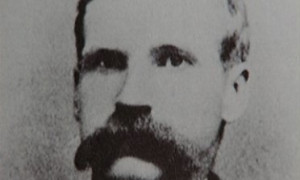Articles
Smuggling has been a problem in the Eastern Townships for a long time. At first, there were no customs offices at all. People could buy whatever they pleased in the U.S. and bring it back over the border, no questions asked. In 1821, the government set up a border post at Stanstead. Some people paid the duty, but many continued to smuggle.
In the early 19th century, there were no police, courts, or prisons in the Eastern Townships. The region was a distant frontier, far from the cities of Lower Canada. In theory, the law was enforced by part-time magistrates living in the scattered settlements. In times of emergency, the magistrates were assisted by the local militia.
--July 3, 2019.
In honour of the 125th anniversary of "Megantic Outlaw" Donald Morrison's death, QAHN is pleased to re-issue the following short article on the response to Morrison's arrest by the Scottish community of the Eastern Townships.
The St. Albans Raid of October 19, 1864 is one of the most celebrated incidents in Border lore. Considered the northernmost engagement of the American Civil War, it involved about twenty Confederate soldiers who, under the command of a young lieutenant, Bennett Young, carried out a successful raid on three banks in St. Albans, Vermont.
Born in 1845 on his parents' farm at Kingscroft, in Barnston Township, Arthur Osmore Norton studied at nearby Barnston Academy. By age 16, Norton was working as a clerk in a local general store. In 1870, he married Helen Richardson of Coaticook. The couple would have two children together.
From 1860 to the early 1900s, the St. Francis Valley was the main centre in Canada for the production of slate. At that time, there were no less than ten slate quarries in the area around Richmond, Melbourne, Kingsey, and Danville. Entire villages grew up around the quarries which provided a living to hundreds of workers for the most part from Great Britain.
Three components make up the explosive combination of black powder: saltpeter (potassium nitrate), sulphur, and charcoal (carbon). In its heyday, black powder had two primary applications: blasting powder for use in mining operations, and gunpowder for hunting.
Since about the 1870s, the inhabitants of this area, some twenty kilometres northeast of Richmond, were aware of the strange substance which veined the rocks on a hillside known as "Webb's Ledge." It was a Welsh miner named Evan Williams, who, visiting his parents in 1881, first identified the substance as the mineral asbestos, and recognized its commercial value.
In its infancy, hydroelectric power in the Eastern Townships was in the hands of a variety of small, local companies.
Beginning in the 1850s, the Eastern Townships were the centre of a massive "copper rush". One of the first copper mines in the area was in Leeds Township. Immense deposits were soon discovered in Acton, Bolton, and most important of all, Ascot, where rich concentrations of copper ore (and sulphur) were discovered in 1859.
Stanstead’s local indigenous stone, and the mainstay of the local economy, is a variety of granite most often referred to as “Stanstead grey.” Stanstead grey has been quarried and worked in and around Beebe (which is now a part of Stanstead) for generations. But what exactly is this durable stone?
In the early years of settlement, farmers had to make their own shoes, harnesses, and other leather necessities. When a cow died, the farmer and his wife would scrape, cure, and stretch the hide. The leather could then be used for making everything from patches for mending clothing to door hinges.
When tanneries began to appear in villages, the nasty chore of curing cowhides was not one that was widely missed by many people.
An animal that was essential to the settlers was the sheep, whose fleece could be used to produce wool. On the farms each spring, sheep would be sheared and the wool washed of its natural grease and dirt, combed, and finally carded. Carding was the untangling of the fibres. Hand cards were used.
The first settlers who were granted land in the Eastern Townships promised to build grist mills and roads within the first two years of settlement. There were few people more important to a settlement than the miller. The village mill was the link between farm and industry.
While workers elsewhere were suffering the work shortages and poverty of the worst part of the Great Depression, the "Three Villages" in the early 1930s were enjoying full employment.
Hunter’s Mills is situated on a side-road about mid-way between Stanbridge East and Frelighsburg, along Route 237.
Built up around a small waterfall on the Pike (Brochets) River, Hunter's Mills takes its name from the Hunter family, who ran a woollen mill at the beginning of the nineteenth century.
Route 247, between Beebe Plain and the Fitch Bay Narrows, is an undulating, winding stretch of road with some lovely unspoiled scenery, picturesque farms, and splendid views of Owl’s Head, across Lake Memphremagog. It’s a beautiful drive.
Although Massawippi is by no means a ghost town, the village is a long way from the vibrant little community it once was. Situated at the junction of Routes 208 and 143, about midway between Stanstead and Lennoxville, the village’s origins date back to the beginning of the 1800s.
A hamlet in Potton Township, Vale Perkins, or East Potton, as it was once known, was named after Samuel Perkins who settled in this vicinity in the 1790s.
Built in 1875, Potton Springs Hotel and its famous sulphur springs attracted thousands of guests from all over eastern North America. The most important local attraction in its day, the spa had its own railway station and post office.
